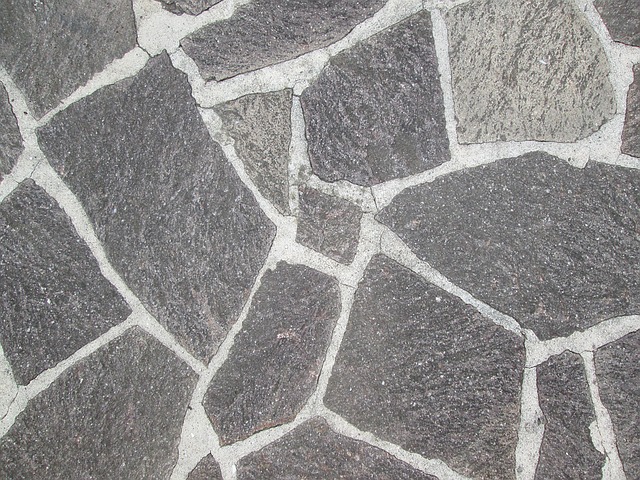Crazy paving

|
| Crazy paving made of natural stone and with mortar joints. |
[edit] Introduction
Crazy paving is a method of hard landscaping that is usually applied to pathways, patios, gardens and driveways and is believed to have originated in ancient Rome. Being functional, hardwearing and decorative, it has proved popular for many suburban gardens and lends itself to various effects of shape and colour.
The term derives from the final, haphazard appearance which can appear to be slightly 'crazy'. Nevertheless, many homeowners have traditionally preferred its informality over the geometric rigidity of a grid effect.
[edit] Getting the effect
Crazy paving can be achieved using stones or broken concrete paving slabs. The latter usually result in limited colour and textural effects. Using naturally riven stone – 40-50mm thick – is thought to give the most pleasing appearance.
The final visual effect will depend on factors such as:
Making up a crazy-paved surface will involve various shapes and colours of stone or slab laid on sand on a suitable base.
Laying requires a bit more thought than laying rectilinear slabs: a good eye for shape and proportion can be a valuable asset in achieving an attractive finish.
When arranging crazy paving, it is usually considered good practice to try to ensure there is a degree of the stones fitting together in some sort of way that avoids huge unsightly, oddly-shaped gaps in between. Any large gaps between stones can be filled with smaller stones.
It is thought best to try to avoid too many straight, continuous joints and to keep the larger stones for the edges, as smaller ones may get detached, especially under a point load.
Filling the joints is achieved either with sand that is brushed-in from all directions, or with a stiff, almost dry mortar that is pressed in with a trowel. Advice from landscape architects, garden centres and other suppliers should be sought when selecting the type of sand and base.
[edit] Related articles on Designing Buildings Wiki
- Binder course.
- Bituminous mixing and laying plant.
- Britain's historic paving.
- Capping layer.
- Glossary of paving terms.
- Groundwater control in urban areas.
- Hazard warning surfaces.
- Highway drainage.
- How to lay block paving.
- Kerbs.
- Landscape design.
- Overview of the road development process.
- Pavement.
- Permeable pavements.
- Types of road and street.
Featured articles and news
RTPI leader to become new CIOB Chief Executive Officer
Dr Victoria Hills MRTPI, FICE to take over after Caroline Gumble’s departure.
Social and affordable housing, a long term plan for delivery
The “Delivering a Decade of Renewal for Social and Affordable Housing” strategy sets out future path.
A change to adoptive architecture
Effects of global weather warming on architectural detailing, material choice and human interaction.
The proposed publicly owned and backed subsidiary of Homes England, to facilitate new homes.
How big is the problem and what can we do to mitigate the effects?
Overheating guidance and tools for building designers
A number of cool guides to help with the heat.
The UK's Modern Industrial Strategy: A 10 year plan
Previous consultation criticism, current key elements and general support with some persisting reservations.
Building Safety Regulator reforms
New roles, new staff and a new fast track service pave the way for a single construction regulator.
Architectural Technologist CPDs and Communications
CIAT CPD… and how you can do it!
Cooling centres and cool spaces
Managing extreme heat in cities by directing the public to places for heat stress relief and water sources.
Winter gardens: A brief history and warm variations
Extending the season with glass in different forms and terms.
Restoring Great Yarmouth's Winter Gardens
Transforming one of the least sustainable constructions imaginable.
Construction Skills Mission Board launch sector drive
Newly formed government and industry collaboration set strategy for recruiting an additional 100,000 construction workers a year.
New Architects Code comes into effect in September 2025
ARB Architects Code of Conduct and Practice available with ongoing consultation regarding guidance.
Welsh Skills Body (Medr) launches ambitious plan
The new skills body brings together funding and regulation of tertiary education and research for the devolved nation.
Paul Gandy FCIOB announced as next CIOB President
Former Tilbury Douglas CEO takes helm.
UK Infrastructure: A 10 Year Strategy. In brief with reactions
With the National Infrastructure and Service Transformation Authority (NISTA).






















